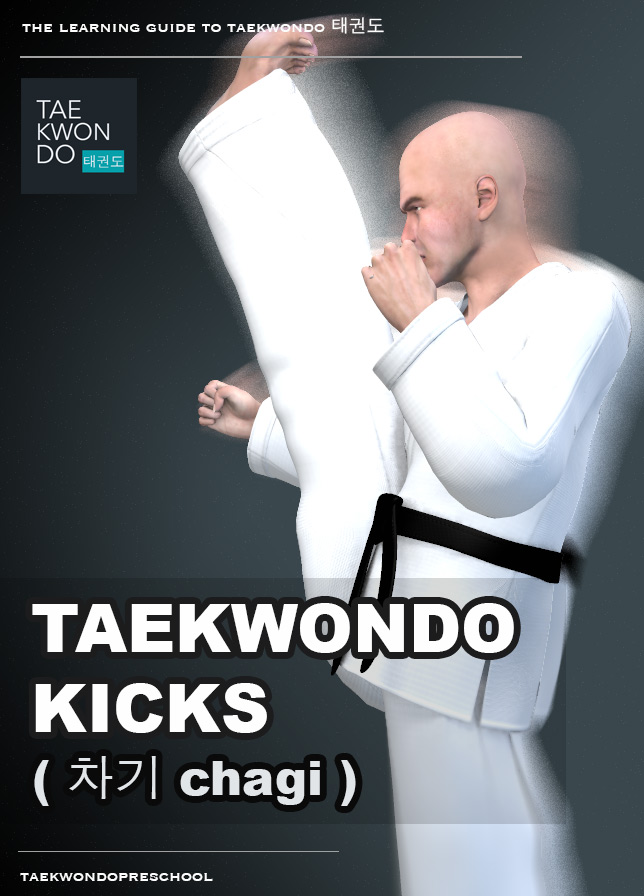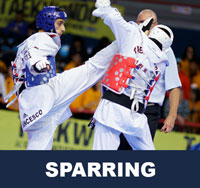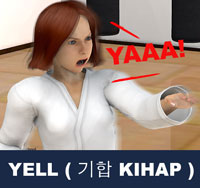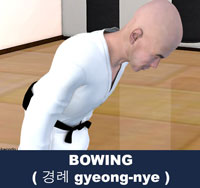Taekwondo 태권도Taekwondo Preschool
Promotion from one geup to the next can proceed rapidly in some schools, since schools often allow geup promotions every two, three, or four months. Students of geup rank learn the most basic techniques first, and then move on to more advanced techniques as they approach first dan. Many of the older and more traditional schools often take longer to allow students to test for higher ranks than newer, more contemporary schools, as they may not have the required testing intervals. View Taekwondo belt levels »
Holding Kick
잡고차기 japgo-chagi
A kick (차기 chagi) is a physical strike using the foot, leg, or knee. The striker relaxes to the extent possible during the strike, tensing the muscles of much of the body only at the time of impact, then relaxing again to recoil the striking part. Relaxation enables the strike to achieve the greatest possible velocity during travel, while rigidity at impact allows the maximum transfer of force.
Difficulty Level: Advanced Technique: Kick ( 차기 chagi )
In taekwondo, the Holding Kick ( 잡고차기 japgo-chagi ) is done when you block an opponents’ attack, then grab and hold the opponents’ wrist ( 팔목 palmok ), while you immediately kick ( 차기 chagi ) the opponent with a Front Kick ( 앞차기 ap-chagi ), Side Kick ( 옆차기 yeop-chagi ), or Roundhouse Kick ( 돌려차기 dollyeo-chagi ) to the mid- or high-section.
The typical example would be the opponent throwing a punch ( 지르기 jireugi ) directly at you, while you block ( makgi 막기 ) with a Single Knife Hand Outward Block ( 한손날 바깥막기 hansonnal-bakkat-makgi ), hold the opponents’ wrist ( 팔목 palmok ), and then throw a Front Foot Side Kick ( 앞발 옆차기 apbal-yeop-chagi ) towards the rib ( 늑골 neuggol ) area of the opponent. Pulling the grabbed hand while you kick ( 차기 chagi ) would increase the penetration damage to the rib ( 늑골 neuggol ) area of the opponent.
The kick ( 차기 chagi ) is mostly seen during self-defense ( 호신술 hosinsool ) applications, one-step sparring, and demonstration events. To promote taekwondo for its emphasis on high kicking and fast hand techniques, schools regularly have demonstrations in tournaments, community events, shopping malls, and parks.
The Holding Kick ( 잡고차기 japgo-chagi ) is not used in World Taekwondo (WT) sparring ( 겨루기 gyeorugi ) due to it being illegal to grab and hold the opponents’ wrist ( 팔목 palmok ). Penalties on any prohibited acts shall be declared by the referee. Penalties are divided into warnings ( 경 고 gyeong-go ) and deduction of points ( 감점 gamjeom ). The technique is more suited for self-defense ( 호신술 hosinsool ) usage.
Self-Defense ( 호신술 hosinsool ) is to protect yourself from being attacked from would-be aggressors. It is a countermeasure that involves defending the health and well-being of oneself from harm and is designed primarily to cause injury or quickly incapacitate an attacker, in addition to being a deterrent against them.
Variations of Holding Kick ( 잡고차기 japgo-chagi )
- Holding Whip Kick ( 잡고 후려차기 japgo-huryeo-chagi )
Training Methods
How well one improves with training depends on several factors, such as the frequency it is engaged in, and the type of feedback that is available for improvement. If a student does not train often enough, reinforcement fades, and he or she is likely to forget what was learned.
When learning the kick ( 차기 chagi ), it is helpful to use mirrors to observe your technique and fix your mistakes immediately. Initially, a student may need focused feedback from a certified Master Instructor ( 사범님 sabeomnim ); however, as they progress, they must develop the ability to self-assess the kick ( 차기 chagi ).
Difficulty of Technique
Taekwondo students of geup ranking learn the most basic techniques first, and then move on to more advanced and difficult techniques as they approach 1st Dan Black Belt. The more difficult the technique, the more practice may be needed for the purpose of improving or mastering it, as in the phrase 'practice makes perfect'. Every technique must display the requisite speed, balance, power and firmness to be realistically used as an attack or defense move.
* Please see a certified Master Instructor ( 사범님 sabeomnim ) for training. Proper guidance and instructions are needed to ensure safe training.
Promotion Tests
Students often undergo periodic testing and grading by their own Master Instructor ( 사범님 sabeomnim ) in order to advance to a higher level of recognized achievement such as a different belt color. They need to demonstrate their proficiency in the various aspects of the art such as the execution of patterns ( 품새 poomse ), which combine various techniques in specific sequences.
Holding Kick ( 잡고차기 japgo-chagi ) is a requirement for the below belt levels (Techniques vary between schools). Promotion from one belt level to the next can proceed rapidly in some schools, since schools often allow geup promotions every two, three, or four months. Students of geup rank learn the most basic techniques first, and then move on to more advanced techniques as they approach first dan black belt. View Promotion Tests »

Training Highlights Summary
The Kick ( 차기 chagi ) contains many key point highlights. There are some that are simple and straightforward but then some are complex and detailed that require repeated training to learn and master.
- method of blocking an opponents’ attack, then grab and hold the opponents’ wrist, while you immediately kick
- suited for self defense ( 호신술 hosinsool ) applications
- not used in sparring ( 겨루기 gyeorugi ) due to it being illegal to grab and hold the opponents’ wrist ( 팔목 palmok )
Strength Requirement of the Technique
Most strikes should generally be thrown with some measure of shifting body weight supporting the blow. The striker in combat should attempt to strike through the target area, not just contact the surface. Some strikes do not need as much strength as they target vulnerable areas such as the eyes ( 눈 nun ), neck ( 목 mok ) or sternum ( 흉골 hyung-gol ). The below is an approximate measurement of how much strength the strike requires from the practitioner to be effective.
Precision of Kicking ( 차기 chagi ) Technique
With proper execution opponents may be stopped with a single striking blow, which lessens the number of further strikes. Some kicks ( 차기 chagi ) can strike with more precision which will often cripple or knockout the opponent. The below is an approximate measurement of how precise the kick ( 차기 chagi ) requires from the practitioner to be effective.
Experienced practitioners learn through repetition and muscle memory when (not just how) to launch particular kicks ( 차기 chagi ), based on the circumstances they are facing.
* Please see a certified Master Instructor ( 사범님 sabeomnim ) for training. Proper guidance and instructions are needed to ensure safe training.
Risk of injury can be reduced by completing an effective warm up consisting of a heart raiser to get your pulse up, followed by sport specific dynamic stretches (stretches whilst moving). Please follow the guidance of a certified Master Instructor or trainer when doing sports related activities. Depending on the intensity of the exercise, cooling down can involve a slow jog or walk, or with lower intensities, stretching can be used. Cooling down allows the heart rate to return to its resting rate. View more information on Warming Up and Cooling Down ».
This article uses material from the Wikipedia articles "Warming Up" and "Cooling Down", which is released under the Creative Commons Attribution-Share-Alike License 3.0.
RESOURCES
This article uses material from the Wikipedia article "Kick" which is released under the Creative Commons Attribution-Share-Alike License 3.0.














































